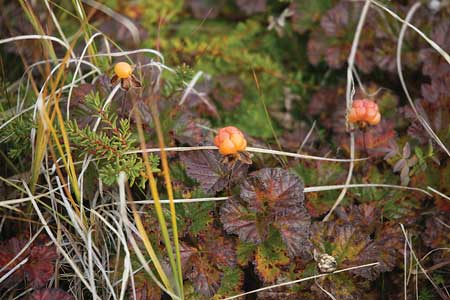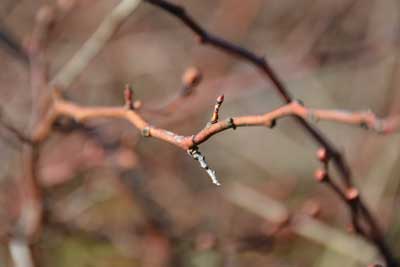NC State Researchers Exploit Plant Compounds for Human Health
INSIDE ACADEMIA
Watch a video about North Carolina State University’s Plants for Human Health Institute and the research into health-promoting plant compounds that takes place there.
Plant foods have long been recognized as good for human health, but specifics on how and why have remained somewhat elusive. Through an integrated approach involving metabolomics, biochemistry, systems biology, pharmacogenomics, plant breeding, and postharvest physiology, North Carolina State University’s Plants for Human Health Institute (PHHI) is identifying the powerful substances in plants that promote health, pinpointing the human organs and systems these substances target, and increasing the health-protective value of food crops and functional foods. The PHHI is part of the North Carolina Research Campus, which is a research consortium of eight universities and 12 industry partners, including Dole Nutrition Research Laboratory, General Mills, and Monsanto Co.
 Investigating Plant Compounds
Investigating Plant Compounds
At the helm of the PHHI is its director, Mary Ann Lila. Because of her training in plant physiology and plant biology and extensive background studying how plant compounds affect human health, Lila was specifically recruited to the North Carolina Research Campus by its benefactor. “David H. Murdock heard me speak at a conference, talking about health foods and fruits and vegetables. As the owner of Dole Foods, he was tuned in to fruits and vegetables and health,” Lila says. She is committed not only to discovering plant compounds and unlocking their human health potential but also to shifting the way Americans view and use plant foods. “In America, we eat a fraction of what we should in terms of fruits and vegetables. It’s pathetic,” Lila says.
Lila is passionate about the secondary compounds in plant foods that can protect and enhance human health and well-being. “I became fascinated with how plants are able to produce secondary compounds and accumulate them in their fruit or in their foliage [so] that when those plants are ingested as a food or topically put on the skin, they can actually interface with human therapeutic targets to counteract chronic diseases or to just improve human metabolism,” Lila explains. The plant compounds that Lila speaks so highly of are not the carbohydrates, fats, proteins, vitamins, and minerals that are present in all natural foods, whether plant-based or animal-based. Secondary plant compounds, or secondary metabolites, are organic compounds in plants that are not directly involved in the normal development of plants. They are integral in defending plants against environmental stressors such as weeds, fungi, insects, and ultraviolet rays. These phytochemicals have biological activity or effects in living organisms that is separate from that of vitamins and minerals. Such compounds include carotenoids such as lutein and lycopene, polyphenols such as anthocyanins and lignans, and glucosinolates. “The plants are developing these chemicals for their own use so that they can ward off environmental stresses, whether it be intense [ultraviolet] light or cold snaps or poor soils. It’s these extra-nutritional compounds that specifically counter human disease problems,” Lila proclaims. “It’s amazing how something working in a plant can combat a human cancer or diabetes, and yet it does, and sometimes way more effectively than synthetic drugs.”
 Berries Bursting with Potency
Berries Bursting with Potency
Lila and her research team travel around the world to study a variety of vegetables and fruits, each having compounds that may be effective against one ailment or another, but there is one plant-food group that is effective against a host of chronic disorders impacting humans, outperforming all other plant foods in the number and types of compounds they contain that benefit human health: berries. “What’s so amazing about berry crops is that they counteract a wide range of different diseases,” Lila says, and berry crops, including grapes and muscadine grapes, “have the highest concentration of phytoactive compounds in them.” Berries contain secondary metabolites that are protective against cardiovascular disease, cancer, obesity, type 2 diabetes, urinary tract infections, and a host of other chronic health disorders.
Berries are also capable of preventing bacteria from forming biofilms and/or becoming pathogenic in the body. According to Lila, the secondary compounds in berries can be even more effective in the human body than antibiotics and other antimicrobials. For example, cranberries contain a proanthocyanin that has an A-type linkage, which makes it incredibly antimicrobial, particularly against fungal and bacterial infections. The compound attaches to pathogenic bacteria, preventing them from anchoring to the wall of the human urethra or intestine, colonizing, and producing toxins. The structure of these compounds is so attractive to bacteria that they fit together like a puzzle, deceiving the bacteria’s natural instinct to defend itself against antimicrobial agents. “If a berry can prevent bacteria from becoming a pathogen in the body, we don’t need antibiotics for that. So we don’t build up more resistant bacteria because they’re simply being washed out because of consumption of berries,” Lila explains.
 Clearly, berries are in a class by themselves in terms of their bioactive compounds, but even among these compact superfruits, certain berries stand out more than others: blueberries and berries that grow in the Alaskan tundra. What makes these berries unique is that they have not just one active compound, such as the glucosinolates in cruciferous vegetables, which have anti-cancer properties. These berries have a combination of different phytoactive compounds that really improve their efficacy against human disease. Blueberries and Alaskan berries “have this cornucopia of different compounds, so if the human body becomes resistant to one, there are other ones that take over. That’s what really makes them powerful,” Lila says. Blueberries have 26 different anthocyanins in them, and Alaskan berries such as bog blueberries, cloudberries, highbush cranberries, lingonberries, and salmonberries—all of which grow only in Alaska—contain phytochemicals that are not present in any other berries. These characteristics give blueberries and indigenous Alaskan berries the ability to be effective against several disorders. Consequently, blueberries have anti-cancer, anti-diabetic, anti-inflammatory, anti-obesity, and anti-neurodegenerative properties. And Alaskan berries have antibacterial, anti-cancer, and anti-neurodegenerative properties as well as phytochemicals that make them effective against cardiovascular disease, DNA damage, and metabolic diseases.
Clearly, berries are in a class by themselves in terms of their bioactive compounds, but even among these compact superfruits, certain berries stand out more than others: blueberries and berries that grow in the Alaskan tundra. What makes these berries unique is that they have not just one active compound, such as the glucosinolates in cruciferous vegetables, which have anti-cancer properties. These berries have a combination of different phytoactive compounds that really improve their efficacy against human disease. Blueberries and Alaskan berries “have this cornucopia of different compounds, so if the human body becomes resistant to one, there are other ones that take over. That’s what really makes them powerful,” Lila says. Blueberries have 26 different anthocyanins in them, and Alaskan berries such as bog blueberries, cloudberries, highbush cranberries, lingonberries, and salmonberries—all of which grow only in Alaska—contain phytochemicals that are not present in any other berries. These characteristics give blueberries and indigenous Alaskan berries the ability to be effective against several disorders. Consequently, blueberries have anti-cancer, anti-diabetic, anti-inflammatory, anti-obesity, and anti-neurodegenerative properties. And Alaskan berries have antibacterial, anti-cancer, and anti-neurodegenerative properties as well as phytochemicals that make them effective against cardiovascular disease, DNA damage, and metabolic diseases.
--- PAGE BREAK ---
Fighting Inflammation and Chronic Disease
 The ability of these berries to counteract metabolic diseases and the mechanism through which they accomplish this are of particular interest to Slavko Komarnytsky, an assistant professor of pharmacogenomics who works with Lila at the PHHI. “[My interest in] plants and human health kind of goes a long way back before I even got interested in science because I come from a small community where people basically managed plants and had plants as a part of their everyday life. … When you grow up in conditions like this you basically get exposed to the medicinal effects of plants and human health from your grandmother,” Komarnytsky says. His area of research, pharmacogenomics, is the scientific study of how food, its nutrients, and its bioactive compounds affect human genes. As humans eat plant foods, the bioactive molecules they contain are absorbed and metabolized. Those molecules are then delivered to various parts of the body where something remarkable happens: “Whenever a cell is presented with … a foreign molecule that’s not coming from its own body, it needs to respond to it. The only way that the cell knows how to respond to it is to change the gene expression level of certain genes, which will produce certain proteins, which will either activate defenses or change the structure of the cell or change the metabolic pathway within the cell in response to that stimulant,” Komarnytsky explains. “These initial changes … are subtle, but they are there.”
The ability of these berries to counteract metabolic diseases and the mechanism through which they accomplish this are of particular interest to Slavko Komarnytsky, an assistant professor of pharmacogenomics who works with Lila at the PHHI. “[My interest in] plants and human health kind of goes a long way back before I even got interested in science because I come from a small community where people basically managed plants and had plants as a part of their everyday life. … When you grow up in conditions like this you basically get exposed to the medicinal effects of plants and human health from your grandmother,” Komarnytsky says. His area of research, pharmacogenomics, is the scientific study of how food, its nutrients, and its bioactive compounds affect human genes. As humans eat plant foods, the bioactive molecules they contain are absorbed and metabolized. Those molecules are then delivered to various parts of the body where something remarkable happens: “Whenever a cell is presented with … a foreign molecule that’s not coming from its own body, it needs to respond to it. The only way that the cell knows how to respond to it is to change the gene expression level of certain genes, which will produce certain proteins, which will either activate defenses or change the structure of the cell or change the metabolic pathway within the cell in response to that stimulant,” Komarnytsky explains. “These initial changes … are subtle, but they are there.”
Two metabolic disorders of particular interest to Komarnytsky are obesity and type 2 diabetes; one is a common risk factor for the other. “Often, people who are obese develop diabetes, [but] some people, even though they are obese, will never develop diabetes. And the question is, ‘Why?’” Komarnytsky says. “What my group thinks is that inflammation is the mediator that basically glues the two together,” he reveals. To prove their theory, Komarnytsky’s research team experimented with C57 black mice. When these mice were placed on a high-fat diet, many of them became obese and developed diabetes, but when the research team shut down the inflammatory processes/response in some of the mice by feeding them a high-fat diet along with the secondary metabolite triptolide, the animals on this diet gained weight but did not develop diabetes.
While the team’s experiment suggests that inflammation is a mediator between obesity and type 2 diabetes, Komarnytsky points out that it doesn’t explain how. Inflammation is a vital part of the body’s immune response, so not all inflammation is bad, but “inflammation and insulin resistance come together—one way or another,” he asserts. According to Komarnytsky, the human body uses insulin resistance as a natural mechanism to deal with situations that can only be resolved with inflammation. A disease, infection, or injury causes the body to elicit a strong pro-inflammatory response, which increases insulin resistance to ensure that the body’s immune and reparative responses have enough glucose to function properly. However, in the case of type 2 diabetes, blood glucose levels are unnaturally high because of an overindulgent diet instead of the body’s natural temporary influx of glucose due to a pathogen or other stress to the body. “Increased blood glucose requires increased production of insulin to control it. As receptors that recognize insulin keep seeing more and more insulin, it’s basically a numbness effect, [and] they stop responding to the insulin,” Komarnytsky says.
The plant compound fed to obese mice in Komarnytsky’s experiment, triptolide, is one of the most potent natural anti-inflammatory agents known; it comes from a Chinese plant that is traditionally used for arthritis. Other anti-inflammatory plant foods such as “cabbage, kale, broccoli, cauliflower… are great for suppressing inflammation in our bodies. Any type of berries that are high in dark purple coloration—blueberries, black currants, cherries, black raspberries, for example—are also quite powerful at suppressing inflammation,” Komarnytsky states. Nevertheless, anti-inflammatory foods do not have the same effect as anti-inflammatory drugs. “They are foods, so when they are digested, they enter our bodies, and after a certain period of time, the bioactive molecules are out,” Komarnytsky explains. “They can’t suppress inflammation in a critical condition, but as a low and systemic signal to suppress inflammation in our bodies, they work very nicely.”
 Plans and Projects
Plans and Projects
The mission of the PHHI is not only to make discoveries about plant foods but to deliver plant-based solutions, so the researchers at PHHI are also working on projects that would help consumers live healthier lives. In one project, PHHI researchers extract bioactive secondary compounds from the pomace of muscadine grapes and fuse them with edible proteins such as soy and whey. This yields a powder that can be used to make power bars, baked goods, smoothies, or other functional foods. The powder allows users to access the benefits of fruits and vegetables in a shelf-stable product that is suitable for extreme conditions such as the desert or space. “NASA and the [U.S.] Army are in stages of development of working with these compounds,” Lila says, “but also we’ve looked at a number of companies and are in stages of negotiation. It’s being used as a medicinal food at some companies and as a cosmeceutical. … We haven’t got a major food company yet; we’re still looking for that.” The PHHI has also made a similar powder with bioactive compounds from kale. “We feel that it’s extremely important to eat the food, not rely on a phytopharmaceutical or encapsulating a form of the food that just pulls out an extract, because these compounds in the plant are working in synergy; they’re working together,” Lila emphasizes. But for consumers who live in areas where accessibility to fresh or frozen plant foods is not possible, such as the desert or space, these powders are practical solutions.
Another project underway is identifying and mapping the mechanisms that enable food crops to produce the compounds that are so beneficial to human health. The initiative, called the Plant Pathways Elucidation Project (P2EP), aims to advance scientific research, create opportunities for industry and consumers, and enhance human health. As part of P2EP, the genomic sequencing of a diploid highbush blueberry was recently completed. This data will help PHHI and other NC State researchers determine the specific genes that are responsible for producing each bioactive plant compound that enhances human health and will bolster their efforts as they transition to clinical research. This information will also help the university’s extension program select and breed blueberries and other food crops with more desirable gene characteristics.
Indisputably, the research, discoveries, and innovations by Lila, Komarnytsky, and other NC State PHHI researchers help inform and transform science at the intersection of human health, nutrition, and agriculture on the North Carolina Research Campus.
 A Man With a Plant Plan
A Man With a Plant PlanDriving through Kannapolis, N.C., one could mistakenly believe that the town has passed its era of productivity. For decades, the town was the location of Cannon Mills Co., a textile manufacturer that served as Kannapolis’s main source of industrial development and employment. But in 2003, the mill shut down, and many of the town’s residents and small businesses moved elsewhere. Kannapolis was on the brink of desertion when David Murdock, the founder and owner of Dole Food Company Inc. (who also owned the mill from 1982 to 1986), purchased the mill and announced plans to create a $1.5 billion state-of-the-art center for scientific research. The old mill buildings were demolished and replaced with several new campus buildings, including the David H. Murdock Core Lab Building, which houses the world’s largest nuclear magnetic resonance machine and other powerful scientific instruments. Today, a town that seemed poised to fade into obscurity is home to a campus for scientific advances in food, nutrition, human health, and agriculture: the North Carolina Research Campus.
Murdock, an active 93-year-old who eats fruits and vegetables daily, is an agile walking advertisement for the benefits of plant foods, and his determination to disseminate the knowledge of campus researchers’ premier findings about the extensive benefits of a plant-based diet has led him to establish a permanent endowment for the campus, constituting $15 million every year.
Toni Tarver is senior writer/editor of Food Technology magazine ([email protected]).
